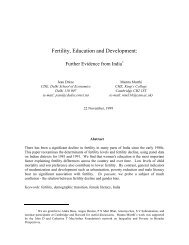Create successful ePaper yourself
Turn your PDF publications into a flip-book with our unique Google optimized e-Paper software.
exchange controls? Which foreign companies would want to plug products they could<br />
neither export to India nor make locally?<br />
<strong>The</strong> wedding invitation was a good excuse to break away from this stalemate in New<br />
Delhi, and make contact with the Indian commercial class in Bombay. <strong>The</strong>re it looked<br />
as if a raw entrepreneurial spirit was straining to break through the discouraging<br />
political crust. Word of the Ambani family and their company Reliance Industries had<br />
spread to Hong Kong as prime examples of this brash new India which might finally<br />
have its day, courtesy of the changes the Gulf War symbolised.<br />
Everything about the Ambanis, in fact, was a good magazine story '<strong>The</strong> young<br />
couple’s courtship had been a stormy one, ready-made for the Bombay show-biz<br />
magazines. <strong>The</strong> bride, Tina Munim, was a girl with a past. She had been a film<br />
starlet, featuring in several of the Hindi-language films churned out by the hundreds<br />
every year in Bollywood most including improbable violence, song-and-dance<br />
routines, and long sequences with the female leads in wet, clingy clothes. Before<br />
meeting Anil, Tina had had a heavy, well-publicised affair with a much older actor.<br />
<strong>The</strong> groom, Anil, was the tear away one of the two Ambani boys. His parents had<br />
frowned on the match. Bombay’s magnates usually tried to arrange matches that<br />
cemented alliances with other powerful business or political families. This one was<br />
not arranged, nor did it bring any more than certain popularity. Hired assailants had<br />
been sent with acid and knives to scar Tina’s face, so went the gossip (apocryphal:<br />
Tina’s face turned out to be flawless).<br />
Anil had threatened suicide if he could not marry Tina, went another rumour. Finally,<br />
the parents had agreed.<br />
<strong>The</strong> father, Dhirubhai, was no less colourful and even more controversial. He had<br />
first worked in Aden in the 1950s. I recalled a stopover there in my childhood,<br />
aboard the S. S. Oronsay, a buff-hulled Orient Line ship, en route to my father’s<br />
posting in London with his Australian bank in 1958. <strong>The</strong> image was of grim, darkbrown<br />
peaks surrounding a harbour of brilliant blue, a host of merchant ships tied up<br />
to moorings, and a busy traffic of launches and barges. <strong>The</strong> trip ashore was by<br />
launch, landing at Steamer Point, where Arabs and Indians besieged the white faces,<br />
trying to sell us Ottoman-style cushions or to drag us into their duty-free shops. Now<br />
someone like those desperate salesmen in Aden was a tycoon in Bombay.<br />
Ambani had got into polyester manufacturing in a big way, and got huge numbers of<br />
Indians to invest in shares of his company, Reliance Industries. In India, the home of<br />
fine cotton textiles, it seemed that people couldn’t get enough polyester. <strong>The</strong> only<br />
constrain on local producers like Reliance was the government’s licensing of their<br />
capacity, or where they built their factories. To jack up his capacity, Ambani had<br />
become a big political fixer. In the recent minority government formation, it was<br />
said; his executives had been shuttling briefcases of cash to politicos all over Delhi.<br />
<strong>The</strong>re had been epic battles, with the press baron Ramnath Goenka of the Indian<br />
Express and with a textile rival from an old Parsi business house, Nusli Wadia. A year<br />
or so earlier, a Reliance public relations manager had been arrested for plotting to<br />
murder Wadia. <strong>The</strong> man had been released, and nothing was moving in the case.<br />
Was it genuine or a frame-up? Indian colleagues were not sure: no conspiracy was<br />
accepted at face value.<br />
So we took our first trip inside India, making our way down to New Delhi Railway<br />
Station in a yellow-and-black cab, one of the 1954 Morris Oxford design still being




